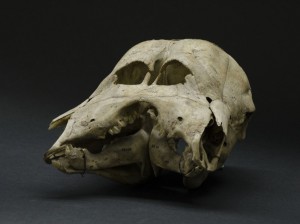Students rushing to class during the last several weeks might have stopped dead in their tracks or at least might have given a second look as they passed a row of illuminated displays in the third-floor hallway that connects Main Building and Curtis Hall.
Curious students who take time to read the display notes posted on the wall might be in for a shock as they realize that they are gazing eye to eye with an actual human skull.
But the skull is not part of a realistic yet morbid Halloween display by the University. Instead, it is one of more than 30 objects on display from Drexel’s Cabinet of Curiosity, a selection of specimens from the University’s rare and unusual collections.

Continuing through the exhibit, a real human skull suddenly seems less unusual when compared to its neighbors. An intricate amputation kit, a silver spoon commemorating the Salem witch trials, and a tool frighteningly named the scarificator, which used multiple spring-loaded blades to bleed physicians’ patients during the 19th century, are just a few of the man-made objects to be seen.
“Normally, for a collection that has 19th-century European art, we would ask, ‘Why do we have these?’” DeGroff said, referring to the human skull and an oyster shell from the Roman city of Pompeii that dates from the famous volcanic eruption in A.D. 79. “But these artifacts were given to us by the first Drexel president, James A. MacAlister.”
The Drexel Collection, which includes more than 6,000 pieces overall, was started when founder A.J. Drexel gave MacAlister $1 million to travel Europe and collect works of art, porcelain and sculpture. The human skull and oyster shell are a testament to the fact that MacAlister brought back more than just fine art.
“The concept of having an exhibition that was outside of our typical collection of decorative arts was fun in and of itself,” DeGroff said.
Natural specimens include a rare head cast of the now-extinct, flightless dodo bird; a specimen of Coco de Mer, or sea coconut, which holds the record as the world’s largest nut; and a 12-inch-high elephant bird egg from a giant bird from Madagascar that may have died out sometime in the 18th century.
Suspended in a jar of ethanol, the aptly named Frankensquid started life as a Orangeback flying squid that was later dissected and the parts reattached incorrectly, creating a uniquely shaped specimen.
“Some of the objects are kind of frightening in the way they look,” DeGroff said. “From the Academy of Natural Sciences, there is a calf with two heads. It died shortly thereafter, but it was born with extra eyes and mouths.”
These strange items have been gathered from The Drexel Collection, the collections of the Drexel University College of Medicine, and the Academy of Natural Sciences of Drexel University. Planning for the exhibit began in the summer, when DeGroff and her colleagues at the Academy and DUCOM began looking for ways to display objects that didn’t fit the overall themes of their collections.
“This has been our most popular exhibit,” DeGroff said. “We’ve had a lot of interest since the objects are so unusual.”
The exhibits in the Rincliffe Gallery change every two months to showcase different selections of Drexel-owned art. The Cabinet of Curiosities will be on display until Dec. 13 and is open to all students during class hours.

